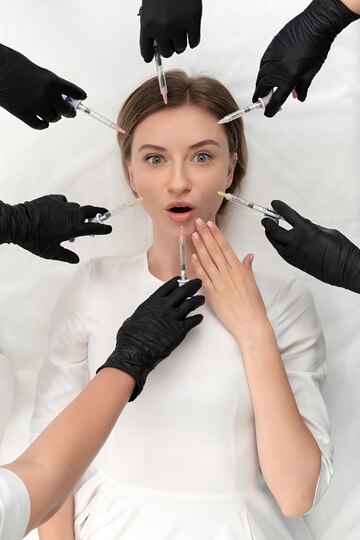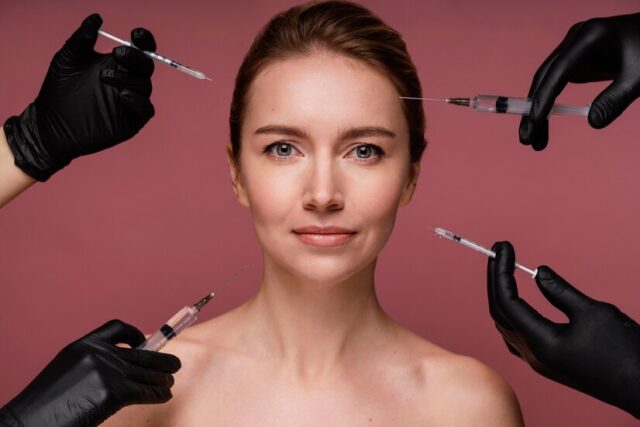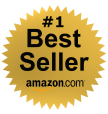Botox for Excessive Sweating: A Life-Changing Solution

Botox for Excessive Sweating: A Life-Changing Solution
Excessive sweating, medically known as hyperhidrosis, can be more than just a nuisance; it can significantly impact one’s confidence and quality of life. But what if there was a solution that could offer relief beyond traditional antiperspirants? Enter Botox, the injectable treatment renowned for its cosmetic benefits, now making waves in the realm of hyperhidrosis management. In this blog series, we’ll delve into the science behind Botox’s effectiveness in combating excessive sweating, explore its safety profile, and hear from individuals whose lives have been transformed by this innovative treatment. If you’re tired of feeling self-conscious and restricted by hyperhidrosis, join us on this journey to discover how Botox could be the life-changing solution you’ve been searching for.
Understanding Hyperhidrosis: The Impact on Daily Life
Hyperhidrosis, characterized by excessive sweating beyond what’s necessary for thermoregulation, can profoundly impact individuals’ daily lives. It extends beyond mere discomfort, affecting emotional well-being, social interactions, and even career choices. Imagine the frustration of constantly soaked clothing, slippery handshakes, or the anxiety of public speaking exacerbated by visible sweat patches. These experiences can lead to decreased self-esteem, avoidance of social situations, and a reluctance to participate in activities that may trigger excessive sweating.
Relationships may suffer as individuals withdraw due to embarrassment or fear of judgment. Furthermore, the constant need to manage sweat can be time-consuming and costly, with frequent clothing changes and the purchase of specialized products. Understanding the multifaceted impact of hyperhidrosis is crucial for developing effective management strategies and providing support to those affected.
The Science Behind Botox: How It Targets Sweat Glands
Botox, short for botulinum toxin, is renowned for its cosmetic use in reducing wrinkles by temporarily paralyzing facial muscles. However, its efficacy in treating hyperhidrosis lies in its ability to inhibit the release of acetylcholine, a neurotransmitter responsible for activating sweat glands. When injected into targeted areas, typically the underarms, palms, or soles of the feet, Botox blocks the signals that stimulate sweat production. This results in a significant reduction in sweating, lasting for several months before the nerve signals gradually regenerate, necessitating repeat treatments.
Unlike topical treatments that only address symptoms superficially, Botox directly interferes with the physiological process of sweating, offering more profound and long-lasting relief. Its precise mechanism of action and proven effectiveness make it a preferred choice for individuals seeking lasting relief from the burdens of hyperhidrosis.
Botox vs. Traditional Treatments: A Comparative Analysis
Comparing Botox with traditional treatments for hyperhidrosis provides valuable insights into their effectiveness, safety, and overall suitability for individuals seeking relief from excessive sweating. Traditional treatments may include topical antiperspirants, oral medications like anticholinergics, iontophoresis (a procedure using electrical currents to block sweat glands), and surgical options such as sympathectomy. While these methods may offer temporary relief for some, they often come with limitations, such as skin irritation from antiperspirants, systemic side effects from medications, or the invasiveness and potential risks of surgery.
In contrast, Botox injections offer a minimally invasive, outpatient procedure with minimal downtime and relatively low risk of side effects when administered by a qualified healthcare professional. Its targeted action directly at sweat glands yields significant reduction in sweating without affecting overall body temperature regulation. Additionally, Botox treatments can be tailored to individual needs, with precise dosing and injection sites based on the severity and location of hyperhidrosis. When considering the comparative effectiveness, safety profile, and convenience of Botox versus traditional treatments, many individuals find Botox to be a more favorable and life-changing solution for managing their hyperhidrosis.
The Role of Botox in Cosmetic Enhancement and Beyond
Beyond its well-known cosmetic applications, Botox plays a pivotal role in addressing various medical conditions, including hyperhidrosis. While its ability to reduce wrinkles and fine lines has earned it widespread recognition in the realm of aesthetic medicine, its therapeutic benefits extend far beyond skin rejuvenation. Botox’s unique mechanism of action, which involves temporarily blocking nerve signals to targeted muscles or glands, makes it a versatile treatment option for a range of conditions characterized by excessive muscle activity or glandular secretion.
In addition to hyperhidrosis, Botox is used to treat medical conditions such as chronic migraines, cervical dystonia (a neurological disorder causing involuntary muscle contractions in the neck), and even overactive bladder. Its effectiveness in these diverse applications underscores the importance of understanding Botox not just as a cosmetic tool but as a valuable therapeutic intervention with the potential to improve quality of life for individuals facing various medical challenges. As research continues to uncover new applications for Botox, its role in medical treatment and enhancement is likely to expand, offering hope and relief to an ever-widening range of patients.
Debunking Myths: Is Botox Safe for Hyperhidrosis?
Despite its widespread use and proven efficacy, misconceptions about the safety of Botox for hyperhidrosis persist. One common concern revolves around the idea of injecting a toxin into the body, leading to fears of potential adverse effects. However, it’s essential to recognize that Botox is derived from a purified form of botulinum toxin type A, which has been extensively studied and approved by regulatory authorities for various medical and cosmetic applications.
When administered by a qualified healthcare provider in appropriate doses, Botox injections for hyperhidrosis are generally safe and well-tolerated. The risk of systemic side effects is minimal, as the toxin remains localized to the injection site and does not spread throughout the body in significant amounts. Common side effects, such as temporary pain or bruising at the injection site, are typically mild and transient. Serious complications are rare and are usually associated with improper administration or underlying medical conditions.
Who’s a Candidate for Botox? Exploring Eligibility Criteria
Determining candidacy for Botox treatment involves assessing various factors, including the severity and location of hyperhidrosis, overall health status, and individual preferences. While Botox is an effective option for many individuals with excessive sweating, not everyone may be suitable candidates. Generally, candidates for Botox treatment are those who experience significant distress or impairment in daily functioning due to hyperhidrosis, despite trying conservative measures such as antiperspirants or lifestyle modifications.
Ideal candidates for Botox are in good overall health and have realistic expectations regarding the outcomes of treatment. They should also be willing to undergo periodic injections to maintain the desired level of sweat reduction. Certain medical conditions or medications may affect eligibility for Botox treatment, so it’s essential to disclose any relevant medical history or concurrent therapies to the healthcare provider.
The Treatment Process: What to Expect During Botox Injections
The Botox injection procedure for hyperhidrosis is relatively straightforward and typically performed in a healthcare provider’s office. Before the treatment, the provider will conduct a thorough evaluation to determine the optimal injection sites and dosage based on the individual’s specific needs and preferences.
During the procedure, the provider will cleanse the treatment area and may apply a topical numbing cream to minimize discomfort. Using a fine needle, Botox is injected into the targeted sweat glands, which may include areas such as the underarms, palms, or soles of the feet. The number of injections and the amount of Botox used will vary depending on the extent of hyperhidrosis and the desired level of sweat reduction.
Longevity of Results: How Often Will You Need Botox for Sweating?
One of the key benefits of Botox for hyperhidrosis is its long-lasting efficacy in reducing sweat production. While individual results may vary, most people experience significant improvement in sweating within a week or two after treatment, with the effects lasting for about four to six months on average.
As the effects of Botox gradually wear off, individuals will notice a gradual return of sweating in the treated areas. To maintain the desired level of sweat reduction, repeat injections are typically needed every four to six months. Some individuals may find that they require less frequent treatments over time as their body’s response to Botox may change.
Combating Social Stigma: Overcoming the Taboo of Excessive Sweating
Excessive sweating, or hyperhidrosis, can carry a significant social stigma, leading to feelings of embarrassment, shame, and isolation among affected individuals. The visible signs of sweating, such as wet patches on clothing or clammy hands, can be perceived negatively by others, leading to misunderstandings and judgments. As a result, many people with hyperhidrosis may go to great lengths to conceal their condition, avoiding social interactions or wearing layers of clothing to hide sweat stains.
Combatting the social stigma associated with hyperhidrosis requires raising awareness and fostering empathy and understanding among the general public. By sharing personal stories, educating others about the condition, and challenging stereotypes, individuals with hyperhidrosis can help break down barriers and create a more supportive and inclusive environment.
In Conclusion, Botox emerges not just as a treatment but as a life-changing solution for those grappling with excessive sweating. At American Laser Med Spa, we’re committed to transforming lives by fostering youthfulness, beauty, and confidence while building a supportive community. Your well-being is our priority, and we’re dedicated to providing the best experience and patient care possible. Ready to reclaim control over your life? Reach out to us at 915-760-5123 or email us at Elpaso@americanlaser-medspa.com to start your journey towards a sweat-free, confident future.







